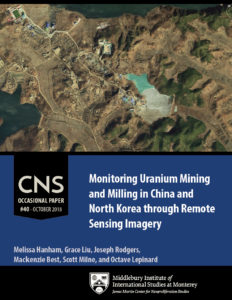October 31, 2018
Melissa Hanham, Grace Liu, Joseph Rodgers, Mackenzie Best, Scott Milne, and Octave Lepinard
Although uranium mining and milling constitute the first step in any nuclear-weapons program, nuclear nonproliferation analysts have devoted surprisingly little attention to monitoring these processes. Understanding and monitoring uranium mines and mills can provide deeper insight into fissile-material production. This report focuses on the insights gleaned from remotely sensed images of known Chinese uranium mines and mills to understand the current status of uranium mining and milling in North Korea.
CNS Occasional Paper #40 quantitatively estimates uranium production at North Korea’s declared uranium mine and identifies three potential, previously undetected North Korean uranium mines and mills.
At present, it is difficult for the International Atomic Energy Agency (IAEA) to identify, let alone resolve, any inconsistency in a state’s reported uranium holdings. Satellite imagery can enhance IAEA safeguards inspectors’ ability to identify active uranium mines and mills and estimate throughput to determine whether the state may be diverting undeclared materials into a clandestine nuclear-weapons program. In addition to satellite imagery, official national publications, import and export data, and other open-source reports can also inform inspectors.
Significant insights can be extracted from analyzing satellite images of these sites, which can provide estimates of production levels. Researchers at the European Safeguards Research and Development Association created a formula that integrates these optical signatures to estimate throughput. The precision of the formula or the validity of Chinese declarations can be tested, and researchers can then apply this formula to estimate throughput of suspected uranium mines and mills in North Korea.
The researchers would like to thank the MacArthur Foundation for their support, and Dr. Will Amidon for his expertise and insight.

